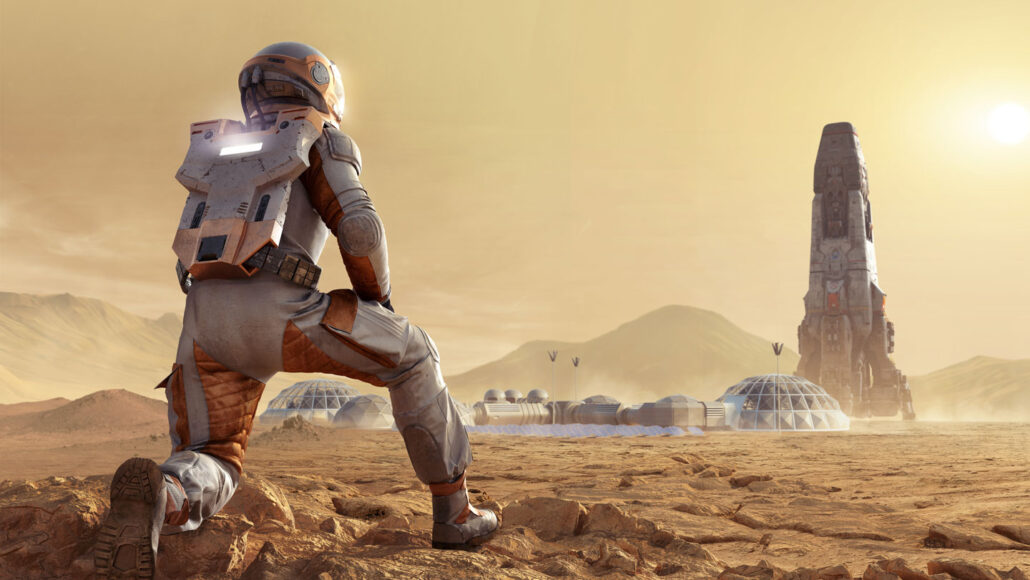Let’s learn about surviving a trip to Mars
Astronauts would face dangers both getting to and surviving on the Red Planet

A trip to Mars may be many years off. But scientists are already figuring out what it would take to keep people safe and healthy on a journey to the Red Planet.
peepo/E+/Getty Images
So far, Mars has been the domain of space robots. Over the last 60 years, many spacecraft have flown by, orbited and even landed on the Red Planet. But human explorers could work faster and be more flexible than machines. Not to mention, setting foot on Mars would be a major milestone in space exploration. That’s why the United States, China and other countries want to send people to Mars. But surviving this adventure would be no easy feat.
A Mars mission would be the farthest journey in human history. At an average 225 million kilometers (140 million miles) away, Mars would take at least six months for astronauts to reach. (It would take at least another six months to get back home). In contrast, Apollo astronauts got to the moon in few days.
While space travel is never free of danger, the length of a roundtrip to Mars poses many extra health risks. For one thing, floating in microgravity for long periods weakens bones and muscles. Plus, it allows fluid to build up in the head, putting pressure behind the eyes and causing vision problems. Artificial gravity machines could help.
But then there’s space radiation to worry about. The Earth’s magnetic field protects astronauts near Earth from high-energy cosmic rays. Those charged particles might raise the risk of cancer and other health problems. On longer journeys, though, astronauts would be exposed for months. Taking certain vitamins could reduce the impacts. But scientists are still working out the details.
Mars explorers will have to pack light to lift off from Earth. But they won’t be able to restock on supplies like astronauts on the space station do. Astronauts on the space station practice for this by growing lettuce and other food in space. Engineers are also developing 3-D printing techniques that could let future Mars astronauts build tools as needed. The material for those tools could come from the astronauts themselves. For instance, astronaut pee could feed yeast that churns out ingredients to make plastic.
Setting up and surviving at a Mars colony would be even more complicated. Since astronauts can’t haul construction materials from Earth, scientists are dreaming up ways for astronauts to use materials on Mars. Long-term visitors would also need plenty of oxygen to breathe. A device on NASA’s Perseverance rover is currently laying the groundwork for a future Mars oxygen factory. The device pries oxygen off molecules of carbon dioxide, the main gas in Mars’ atmosphere.
Planning for a trip to Mars isn’t just about protecting astronauts. It’s also about protecting Mars from astronauts. Humans are teeming with microbes. And spreading those microbes could compromise the search for life on Mars. As a result, a key part of responsible space exploration is making sure Earth germs don’t infect other planets.
Want to know more? We’ve got some stories to get you started:
Preparing for that trip to Mars Space farming techniques, next-generation rockets and 3-D printing could all factor into a successful trip to Mars. (2/22/2018) Readability: 6.6
Surviving Mars missions will take planning and lots of innovation En route to Mars, astronauts will face health risks from microgravity, radiation and more. (10/22/2020) Readability: 8.0
How a year in space affected Scott Kelly’s health A comparison to his twin looks at how long-term spaceflight changes the human body. (5/17/2019) Readability: 7.3
Explore more
Explainer: Gravity and microgravity
The ultimate getaway — visiting the Red Planet
Analyze This: Insect shells could help builders on Mars
En route to Mars, astronauts may face big health risks
The Perseverance rover split CO2 on Mars to make breathable air
Want a tougher space suit? Just add liquid
Here’s how a new sleeping bag could protect astronauts’ eyesight
Space travel may harm health by damaging cells’ powerhouses
Staying grounded in space requires artificial gravity
Human waste could power plastic-making in space
Keeping space missions from infecting Earth and other worlds
Activities
Design your own sustainable Mars colony with guidance from NASA. Take inspiration from communities on Earth and learn about the limitations of the Martian environment to build a model of your ideal human base on the Red Planet. Or, follow NASA’s instructions to build your own model Mars’ rover.







